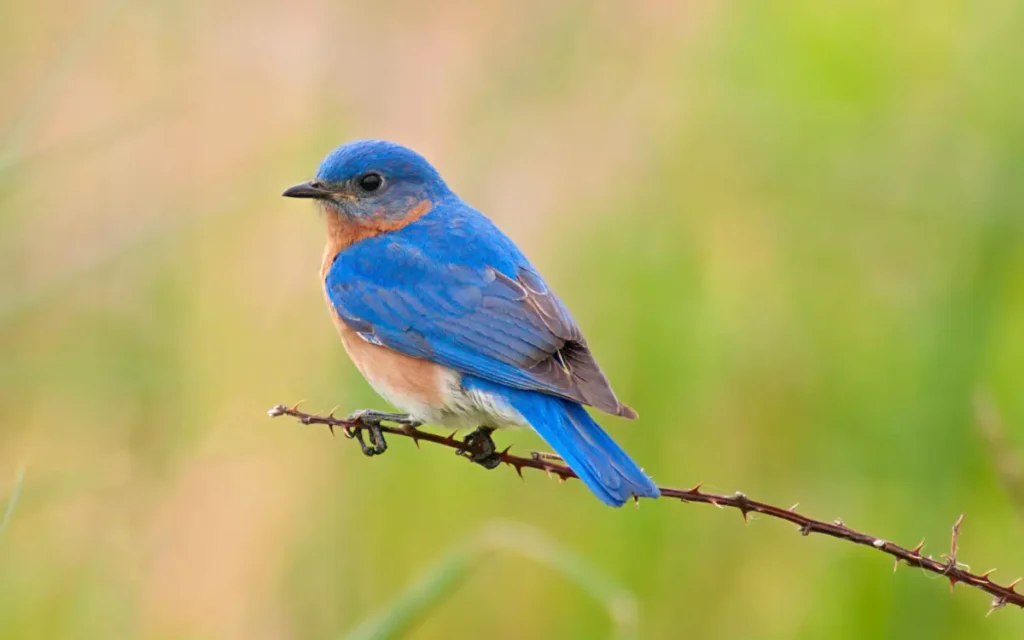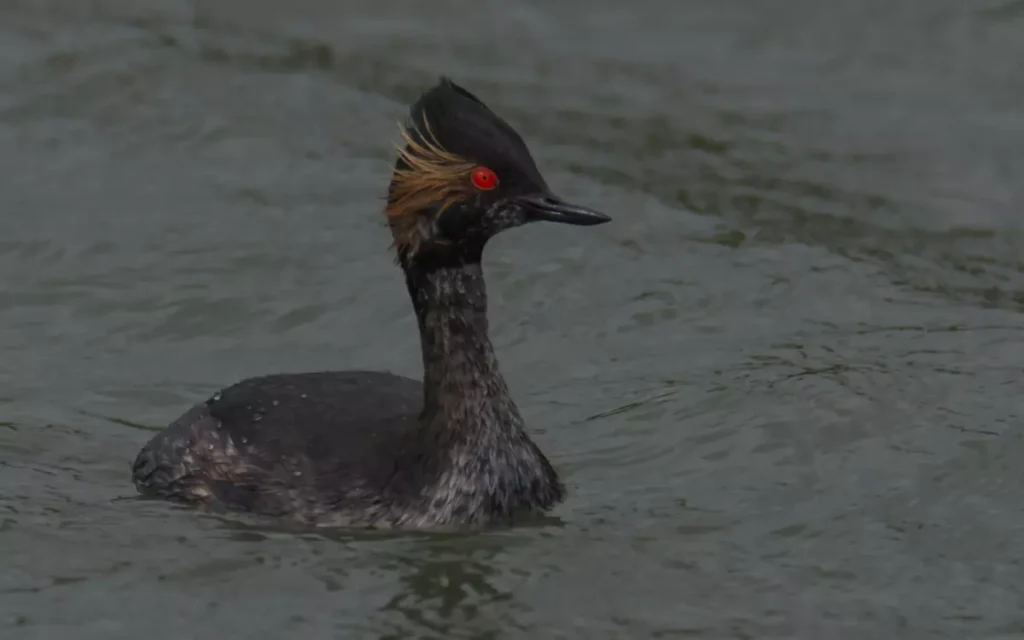20 Birds That Start With E
Birds starting with the letter “E” bring remarkable diversity, from the colorful Eastern Bluebird to the towering Emu. Each species has unique traits, fascinating habitats, and plays a special role in nature.
This list shares each bird’s scientific name, location, and a fun fact, making it an engaging way to discover and appreciate the uniqueness of these amazing birds.
20 unique birds beginning with the letter “E.”
1.Eastern Bluebird

The Eastern Bluebird (Sialia sialis) is a charming North American songbird, admired for its bright blue feathers and sweet, melodious songs. Often spotted in open woodlands and fields, this small bird brings a splash of color and music to the landscape.
- Scientific Name: Sialia sialis
- Location: North America
Fun Fact: Known for their vibrant blue color and melodic songs, they brighten up open woodlands and fields with their charm and music.
2.Emu

The Emu (Dromaius novaehollandiae), native to Australia, is an impressive flightless bird known for its towering stature and unique, shaggy feathers. As the second-largest bird in the world, Emus are fast runners, reaching speeds up to 30 mph, making them well-adapted to their open, rugged habitats.
- Scientific Name: Dromaius novaehollandiae
- Location: Australia
Fun Fact: Emus are the second-largest birds in the world, after the ostrich, and can sprint at impressive speeds on their strong legs.
3.European Robin

The European Robin (Erithacus rubecula) is a beloved songbird native to Europe and parts of Asia, known for its bright orange chest and friendly, curious nature. Often spotted in gardens and woodlands, this small bird has become an iconic symbol of Christmas, especially in the United Kingdom.
- Scientific Name: Erithacus rubecula
- Location: Europe and parts of Asia
- Fun Fact: Often seen as a symbol of Christmas in the UK.
4.Elegant Tern

The Elegant Tern (Thalasseus elegans) is a slender, graceful seabird recognized by its sharp orange bill and streamlined shape. This bird is often seen skimming along the Pacific coasts of the Americas, catching fish with its distinctive diving technique.
- Scientific Name: Thalasseus elegans
- Location: Coastal regions of the Americas
- Fun Fact: Known for its sleek, streamlined shape and vibrant orange bill.
5.Egyptian Goose

The Egyptian Goose (Alopochen aegyptiaca) is a striking waterfowl with distinctive eye patches, native to sub-Saharan Africa and parts of Egypt. Revered in ancient Egyptian art, this bird is often found around lakes and rivers.
- Scientific Name: Alopochen aegyptiaca
- Location: Sub-Saharan Africa and Egypt
- Fun Fact: Featured in ancient Egyptian art, symbolizing beauty and grace.
6.Eastern Meadowlark

The Eastern Meadowlark (Sturnella magna) is a brightly colored bird with a cheerful yellow belly and a beautiful flute-like song. Commonly seen in grasslands across North and Central America, it’s loved for its musical tunes.
- Scientific Name: Sturnella magna
- Location: North and Central America
- Fun Fact: Known for its flute-like song, adding melody to open fields.
7.Eurasian Eagle-Owl

The Eurasian Eagle-Owl (Bubo bubo) is one of the world’s largest owls, with striking orange eyes and powerful talons. Found across Europe, Asia, and North Africa, this owl is a skilled hunter in varied landscapes.
- Scientific Name: Bubo bubo
- Location: Europe, Asia, and North Africa
- Fun Fact: One of the largest owl species, with a wingspan up to 6 feet.
8.Evening Grosbeak

The Evening Grosbeak (Coccothraustes vespertinus) is a robust, colorful songbird found in North America. With its bold colors and strong bill, it’s well-equipped for cracking seeds, adding beauty to boreal forests.
- Scientific Name: Coccothraustes vespertinus
- Location: North America
- Fun Fact: Named for its evening calls and strong, seed-cracking bill.
9.Eared Grebe

The Eared Grebe (Podiceps nigricollis) is a small, elegant waterbird with vivid red eyes and unique breeding plumage. Found across North and South America, it performs elaborate courtship dances in spring.
- Scientific Name: Podiceps nigricollis
- Location: North and South America
- Fun Fact: Known for elaborate courtship displays and striking red eyes.
10.Eastern Whip-poor-will

The Eastern Whip-poor-will (Antrostomus vociferus) is a nocturnal bird that sings a distinctive “whip-poor-will” call. Found in Eastern North America, this bird is a master of camouflage in forested areas.
- Scientific Name: Antrostomus vociferus
- Location: Eastern North America
- Fun Fact: Named for its repetitive “whip-poor-will” call at dusk and dawn.
11.Ecuadorian Hillstar

The Ecuadorian Hillstar (Oreotrochilus chimborazo) is a unique hummingbird adapted to high altitudes in the Andes. Known for its vibrant colors, this bird feeds on nectar from alpine flowers in cold mountain climates.
- Scientific Name: Oreotrochilus chimborazo
- Location: Andes mountains in Ecuador
- Fun Fact: One of few birds to thrive at high altitudes in freezing temperatures.
12.Eastern Phoebe

The Eastern Phoebe (Sayornis phoebe) is a small, plain-looking flycatcher with a loyal habit of nesting near human structures. Found across the Eastern U.S., it’s known for its gentle “phoebe” call and tail-wagging behavior.
- Scientific Name: Sayornis phoebe
- Location: Eastern United States
- Fun Fact: Often wags its tail and nests near human structures.
13.Eurasian Curlew

The Eurasian Curlew (Numenius arquata) is a large shorebird with a long, down-curved bill ideal for probing mudflats. It’s commonly found along Europe, Asia, and Africa’s coastlines, known for its haunting, bubbling call.
- Scientific Name: Numenius arquata
- Location: Europe, Asia, and Africa
- Fun Fact: Recognizable by its long, curved bill, used for foraging in mudflats.
14.Elegant Crescentchest

The Elegant Crescentchest (Melanopareia elegans) is a small, striking bird with a unique crescent-shaped pattern on its chest. Found in South America, this bird is often seen hopping through scrublands and grasslands.
- Scientific Name: Melanopareia elegans
- Location: South America
- Fun Fact: Named for the distinctive crescent pattern on its chest.
15.Eastern Screech-Owl

The Eastern Screech-Owl (Megascops asio) is a small, camouflaged owl known for its trilling calls rather than screeches. It’s common in Eastern North America, nesting in tree cavities and urban areas.
- Scientific Name: Megascops asio
- Location: Eastern North America
- Fun Fact: Despite its name, it makes a trilling sound rather than a screech.
16.European Starling

The European Starling (Sturnus vulgaris) is a highly adaptable bird with iridescent feathers and strong social behavior. Native to Europe, it’s now widespread globally, known for its vocal mimicry and flocking displays.
- Scientific Name: Sturnus vulgaris
- Location: Europe, North America, and Asia
- Fun Fact: Famous for its iridescent plumage and ability to mimic other bird calls.
17.Eurasian Jay

The Eurasian Jay (Garrulus glandarius) is a colorful and intelligent bird, known for storing acorns to help forests regenerate. Found across Europe and Asia, it’s recognizable by its blue wing patch and shy behavior.
- Scientific Name: Garrulus glandarius
- Location: Europe and Asia
- Fun Fact: Helps with forest regeneration by storing and spreading acorns.
18.Egyptian Vulture

The Egyptian Vulture (Neophron percnopterus) is a distinctive, small vulture with a white body and yellow face. Found in Africa, Europe, and Asia, it’s notable for using tools, like rocks, to break open eggs.
- Scientific Name: Neophron percnopterus
- Location: Africa, Europe, and Asia
- Fun Fact: Known for using tools, like rocks, to break open eggs.
19.Elliot’s Pheasant

Elliot’s Pheasant (Syrmaticus ellioti) is a beautifully marked pheasant native to China, prized for its colorful plumage. Named after American ornithologist Daniel Giraud Elliot, this bird lives in dense mountain forests.
- Scientific Name: Syrmaticus ellioti
- Location: China
- Fun Fact: Named after ornithologist Daniel Giraud Elliot.
20.Eurasian Spoonbill

The Eurasian Spoonbill (Platalea leucorodia) is a wading bird with a distinctive spoon-shaped bill, ideal for sweeping through water to find food. Found in Europe, Asia, and North Africa, it’s a graceful sight in wetlands.
- Scientific Name: Platalea leucorodia
- Location: Europe, Asia, and North Africa
- Fun Fact: Recognizable by its spoon-shaped bill used to sift food in water.
Related article
FAQs
What is the largest bird in this list?
The Emu is the largest bird in this list and the second-largest bird in the world.
Which bird is known for its beautiful song?
The Eastern Bluebird and Eastern Meadowlark are both known for their melodic songs.
Why is the European Robin associated with Christmas?
In the UK, the European Robin is often seen on Christmas cards as a holiday symbol.
Do any of these birds use tools?
Yes, the Egyptian Vulture uses rocks to break open eggs.
Which bird on this list has a unique bill shape?
The Eurasian Spoonbill has a distinct spoon-shaped bill, perfect for sifting food in water.






